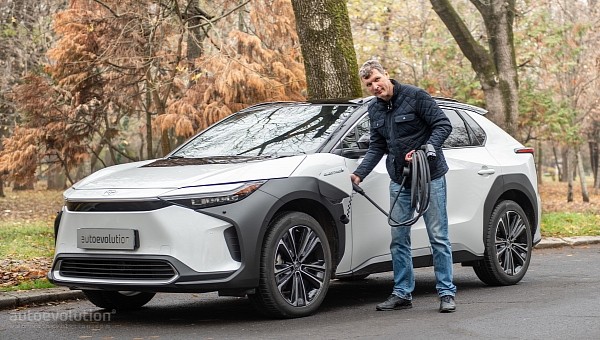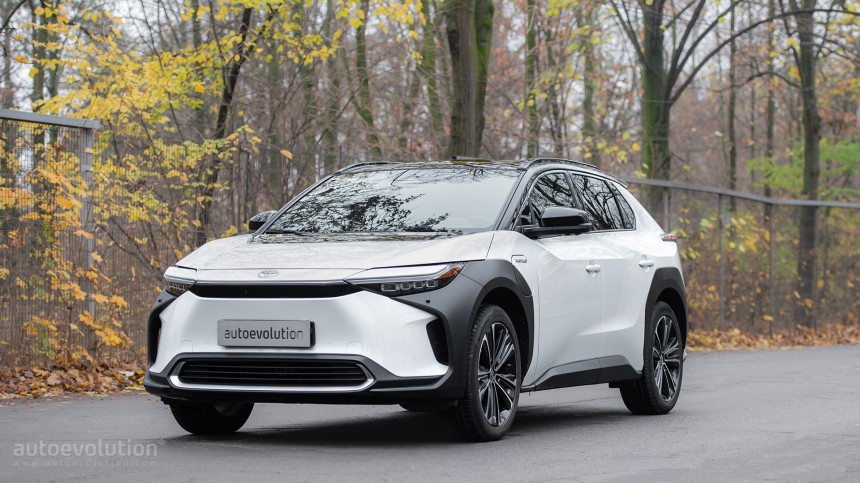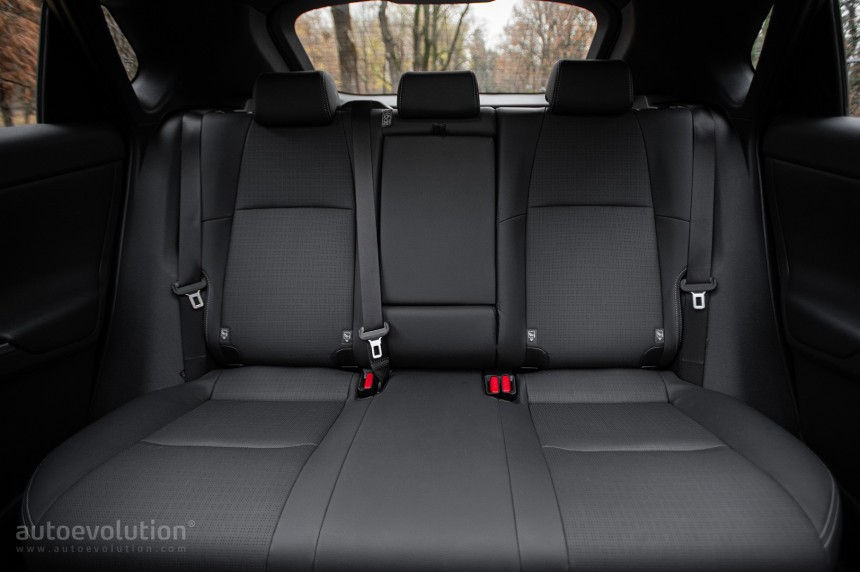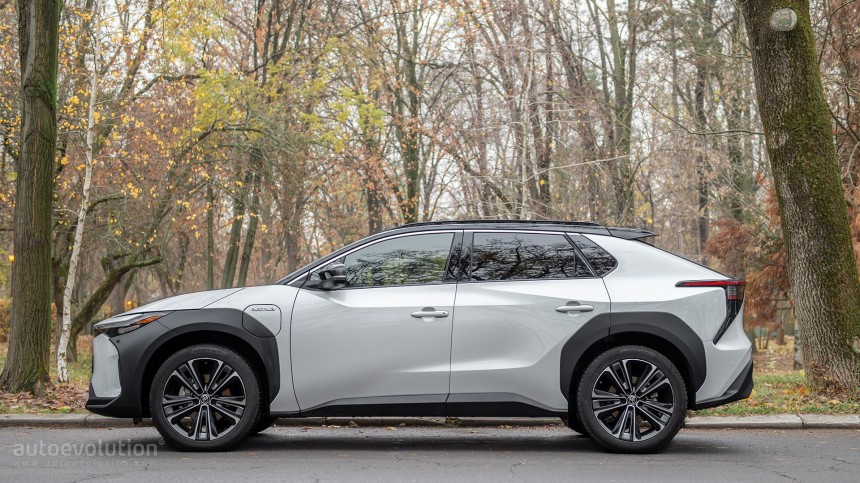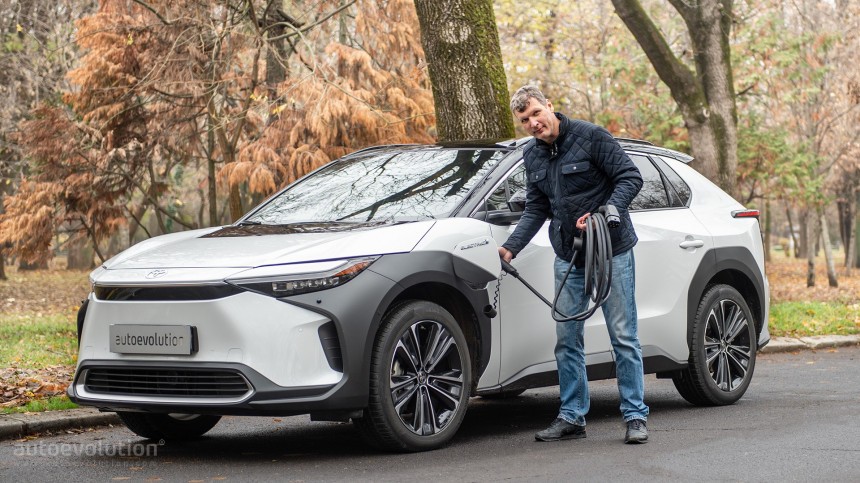Driven: 2022 Toyota bZ4X EV – Baby Steps With Big Shoes
Somehow, I'm like Toyota. I didn't want to jump into the EV trend as soon as it appeared. Instead, I have waited to see how things evolve, and I let others pay the price for automakers' mistakes. Toyota did the same. More than a decade ago, they started the electrification program with the Prius. Still, the automaker studied electric vehicles long and hard, before coming up with this: the bZ4X. What a strange name, what a mixed-feelings car!
Toyota made this car with Subaru, although since the model I tested was an FWD-only vehicle, I may say that for this version, those guys were taking a break. I took the key of this car on a cold winter morning after stepping out of my warm, ICE-powered vehicle. Before taking it for a spin, I had to do the standard procedure for checking the vehicle for scratches and bruises. After all, it was a drive-test vehicle, and things can happen. So, I noticed its exterior.
In addition, there were so many straight lines sculptured on the bodywork that I bet this vehicle will be a nightmare for any bodyshop to fix. At some point, though, they somehow overdid it. The bZ4X doesn't need a black area on the hood.
The angular lines of the LED headlights and the massive, broad front bumper cause mixed feelings. Somehow I liked it, but not too much. Another unusual design element is at the back of the vehicle, where the automaker installed a two-piece roof spoiler on top of the tailgate. Two oversized fins were placed on the upper sides, with a huge gap between them. Someone should tell them that some air goes between those two elements, too. But I get it. It's just for the look. And if the front fascia made me wonder if I liked it or not, this one caught my attention, and I find it, somehow, attractive. The rear LED taillights look great, especially thanks to the broad strip light that unites them. Finally, Toyota installed a two-piece rear bumper with a black lower area. It just matches the rest of the clad that protects the lower bodywork from... curbs and, maybe, sidewalk.
On the center console, there is a rotary knob. You can push and turn it left or right for reversing or driving forward, respectively. The buttons for the sound system's volume are tiny and placed at the bottom of the center screen. For the driver, that's fine because they will use the buttons from the steering wheel, but for the front passenger, it is going to be more difficult. Guys, please bring back the turning knob. Honda did that before with the Civic and then put that little round button back.
Another interesting feature of the car is the driver monitor. Right in front of the steering wheel is a sensor that looks at the driver's face and detects if they're watching the road or just looking elsewhere. If you cover that sensor with your arm while turning or look left and right at a crossroad, a beep will tell you to look dead ahead.
The version you see here features a panoramic glass roof that brings more daylight into the cabin, and it feels wonderful. There is a pair of bolstered front seats and a bench for three in the rear that can be split-folded to expand the trunk area. As for the materials, there is always room for improvement. Toyota mixed a nice-touching fabric on the dashboard with hard plastic on some other areas.
The most unusual thing for a 2022 vehicle is the glove compartment. Or the lack of it, to be more precise. The Japanese engineers needed a place to install the heat pump, and they hid it behind the dashboard. So, bye-bye, glovebox. To compensate, the automaker installed a huge center storage compartment between the front seats and another storage area at the bottom of the center stack, fitted with a pair of USB-C ports.
If you want to charge your phone, a special compartment on the center console features wireless charging. If your phone doesn't support that, there is a USB port in the same area so you can plug it in. But then, you can't close that lid anymore. They could've left a small cut-out to let the charging cable pass through while keeping the phone outside.
As expected for an electric vehicle, the instant torque came briskly when I pressed the skinny pedal down. Tires struggled for traction, and the ESP light frantically blinked on the dash. I could've deactivated it prior to that but, after all, who does that when they drive the bZ4X EV around? If you want a vehicle that's meant to be driven like that, take the Supra. That will do it.
Steering is quite precise. The model I tested didn't have the drive-by-wire feature, which was not installed due to legal debates with authorities. Still, there was very little feedback from the wheel. It was numb but accurate. I've tried game sets with better feedback, but as a daily, you won't miss that. After all, it's a family-oriented crossover, not a sportscar.
If you want to go on vacation with this car, you should know that the trunk can hold 452 liters (15.9 cu-ft) and can go up to 1,589 liters (56.1 cu-ft) with the rear seats folded down. But in that case, only two people could get on board the vehicle.
I started the car with the 71.4 kWh battery fully charged, and the vehicle showed an estimated range of 400 km (249 miles). As soon as I turned on the heating, it instantly dropped 62 miles (100 km). Since it was cold outside, I had to choose between being warm or driving more. Fortunately, Toyota thought about this and offered the option of heated steering wheel and seats. On short, up to 10 minutes trips, that was fine. But then the windows got foggy, so I had to turn the heater on.
The energy consumption for the entire testing cycle (city/highway) was about 83.8 MPGe (that would be approximately 25 kWh/100 km). I drove it with and without heating, depending on the travel. I noticed that the vehicle could get up to 209 MPGe (10 kWh) at a steady 35 mph (56 kph) speed. So, if you really want to go far, all you have to do is to keep the car there. Thanks to the safety pack that included adaptive cruise control, that was easy. As expected, the vehicle could also stay in its traffic lane.
Toyota offers the bZ4X with an extensive safety package, even for the base model. That's why it managed to get impressive EuroNCAP crash-test scores. At the time of writing, it wasn't tested by the IIHS. This crossover offers over 80% protection for all passengers and has a 91% score for the safety assist systems. In addition, pedestrians are protected in a respectable proportion of 79%. Considering this, I'd expect it to get high grades on American tests as well.
If you don't plan to use it for more than 60 miles (97 km) per day, it will be worth it. Yet, if you know that you're willing to spend a lot of time outdoors and spend your weekends in remote areas in tiny homes, the bZ4X is not for you. In addition, you can't dry your hair by plugging in a hair dryer since it doesn't come with a V2L system. But yes, it's a good start for Toyota in the EV segment.
Design evaluation
There are crossovers that, from a distance, look like hatchbacks. Take a look, for instance, at the Ioniq 5 and tell me it doesn't look like one. Well, Toyota pushed its design department to pen a vehicle that would look like an SUV or, at least, a crossover. The job was not easy, but somehow the art&pencil division did it properly. The black, unpainted areas around the wheel arches and on the side sills leave the impression of a rugged, ready-to-try trails and paths vehicle.In addition, there were so many straight lines sculptured on the bodywork that I bet this vehicle will be a nightmare for any bodyshop to fix. At some point, though, they somehow overdid it. The bZ4X doesn't need a black area on the hood.
The angular lines of the LED headlights and the massive, broad front bumper cause mixed feelings. Somehow I liked it, but not too much. Another unusual design element is at the back of the vehicle, where the automaker installed a two-piece roof spoiler on top of the tailgate. Two oversized fins were placed on the upper sides, with a huge gap between them. Someone should tell them that some air goes between those two elements, too. But I get it. It's just for the look. And if the front fascia made me wonder if I liked it or not, this one caught my attention, and I find it, somehow, attractive. The rear LED taillights look great, especially thanks to the broad strip light that unites them. Finally, Toyota installed a two-piece rear bumper with a black lower area. It just matches the rest of the clad that protects the lower bodywork from... curbs and, maybe, sidewalk.
Interior Assessment
I like clean interiors, uncluttered by buttons and switches spread all over the place. Since the Japanese culture is built on the minimalism trend, Toyota's designers managed to replicate that styling inside the bZ4X. The clean-looking dashboard has almost no buttons at all. Unfortunately, there is no rotary knob for the sound system's volume either. There is a small screen in front of the driver that is placed in an unusual position, closer to the windshield, and there's a second one above the center stack, for the infotainment system. The former might be difficult to see for shorter persons, but the second is brilliant, with an excellent resolution. This offers wireless connectivity with Apple CarPlay and wired connection with Android Auto devices. Toyota has decided this after several discussions regarding the use of chips and the necessary updates.On the center console, there is a rotary knob. You can push and turn it left or right for reversing or driving forward, respectively. The buttons for the sound system's volume are tiny and placed at the bottom of the center screen. For the driver, that's fine because they will use the buttons from the steering wheel, but for the front passenger, it is going to be more difficult. Guys, please bring back the turning knob. Honda did that before with the Civic and then put that little round button back.
Another interesting feature of the car is the driver monitor. Right in front of the steering wheel is a sensor that looks at the driver's face and detects if they're watching the road or just looking elsewhere. If you cover that sensor with your arm while turning or look left and right at a crossroad, a beep will tell you to look dead ahead.
The version you see here features a panoramic glass roof that brings more daylight into the cabin, and it feels wonderful. There is a pair of bolstered front seats and a bench for three in the rear that can be split-folded to expand the trunk area. As for the materials, there is always room for improvement. Toyota mixed a nice-touching fabric on the dashboard with hard plastic on some other areas.
If you want to charge your phone, a special compartment on the center console features wireless charging. If your phone doesn't support that, there is a USB port in the same area so you can plug it in. But then, you can't close that lid anymore. They could've left a small cut-out to let the charging cable pass through while keeping the phone outside.
Driving Take
I enjoyed the driving position. The seats are very comfortable, and their side bolstering keeps you in place during hard cornering because, yes, this Toyota can still tackle tight turns at speeds high enough to throw your face onto the side window. And then receive warning sounds from the driver's monitor. In the back, there's plenty of room for three adults. The almost flat floor doesn't force the middle-seated passenger to squeeze their feet left and right. If you have small children, they can be properly secured in child seats since the bZ4X features Isofix anchoring points.As expected for an electric vehicle, the instant torque came briskly when I pressed the skinny pedal down. Tires struggled for traction, and the ESP light frantically blinked on the dash. I could've deactivated it prior to that but, after all, who does that when they drive the bZ4X EV around? If you want a vehicle that's meant to be driven like that, take the Supra. That will do it.
Everyday Living
Toyota tried to create a comfortable ride, but due to the car's weight and the big wheels shod in low-profile tires, it wasn't as soft as in a Camry, for instance. You could feel every bump in the road, not exactly as a kick in the back but more as a drop on a couch. On the plus side, the vehicle managed to be surprisingly good on tight turns, with just mild understeer. Take into account that we have tested the FWD version of the bz4X, so the rear axle didn't help push the car.If you want to go on vacation with this car, you should know that the trunk can hold 452 liters (15.9 cu-ft) and can go up to 1,589 liters (56.1 cu-ft) with the rear seats folded down. But in that case, only two people could get on board the vehicle.
I started the car with the 71.4 kWh battery fully charged, and the vehicle showed an estimated range of 400 km (249 miles). As soon as I turned on the heating, it instantly dropped 62 miles (100 km). Since it was cold outside, I had to choose between being warm or driving more. Fortunately, Toyota thought about this and offered the option of heated steering wheel and seats. On short, up to 10 minutes trips, that was fine. But then the windows got foggy, so I had to turn the heater on.
Toyota offers the bZ4X with an extensive safety package, even for the base model. That's why it managed to get impressive EuroNCAP crash-test scores. At the time of writing, it wasn't tested by the IIHS. This crossover offers over 80% protection for all passengers and has a 91% score for the safety assist systems. In addition, pedestrians are protected in a respectable proportion of 79%. Considering this, I'd expect it to get high grades on American tests as well.
Test Drive Roundup
Toyota wanted to join the electric revolution and did that with this crossover. We already know that Toyota will launch more than a dozen of EVs by the end of 2030, and the bZ4X EV is just the appetizer. It's not perfect, that's for sure, but its price won't break your bank either. In addition, if you'd charge it at home, overnight, it should be more than enough for your daily commute. Its price, without any governmental help, is $49,000 for the Limited trim level we've tested. It's not a bargain, though. But after all, it's an EV, so you can't expect it to be priced as a Corolla.If you don't plan to use it for more than 60 miles (97 km) per day, it will be worth it. Yet, if you know that you're willing to spend a lot of time outdoors and spend your weekends in remote areas in tiny homes, the bZ4X is not for you. In addition, you can't dry your hair by plugging in a hair dryer since it doesn't come with a V2L system. But yes, it's a good start for Toyota in the EV segment.
Pros:
- Spacious, great for school runs
- Doesn't look like a raised hatchback
- Driving position doesn't make you feel like you're sitting on a car but in it
- The JBL sound system is a must-buy, just to cover all that rolling noise
- The fabric on the dashboard is excellent against sun glare
Cons:
- The instrument panel is placed in a weird position and you can't see all of it
- The range can barely cover a weekend without charging
- Due to its low-profile tires, the car struggles in the comfort department
- No frunk
- No glovebox
About the author: Tudor Serban

Tudor started his automotive career in 1996, writing for a magazine while working on his journalism degree. From Pikes Peaks to the Moroccan desert to the Laguna Seca, he's seen and done it all.
Full profile
